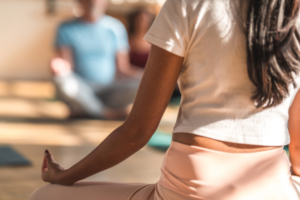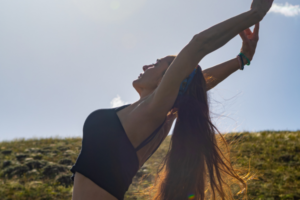Introduction
Breathing is an automatic function of our bodies that we often overlook. However, it holds a secret key to both our physical and emotional well-being. Mindful breathing, or the practice of being fully aware and present with our breath, can be transformative in managing stress, increasing focus, and promoting overall health. This article will guide you through seven powerful techniques of mindful breathing, suitable for beginners.
1. Belly Breathing
Belly breathing or diaphragmatic breathing is one of the most basic and effective mindful breathing techniques. By focusing on taking deep breaths into your belly rather than shallow breaths into your chest, you engage your diaphragm and increase oxygen flow to your body, which can promote calmness and relaxation.
To practice this technique, find a comfortable place to lie down and place one hand on your belly and the other on your chest. Breathe in deeply through your nose, filling your belly with air, and then breathe out through your mouth. Try to focus on making the hand on your belly rise and fall, rather than the one on your chest.
It might take some practice to get used to belly breathing, but it’s a great way to become more aware of your breath. Regularly practicing this technique can help reduce stress and improve lung function.
2. Box Breathing
Box breathing is another simple yet powerful technique. It involves inhaling, holding the breath, exhaling, and holding the breath again, each for an equal count, like the four equal sides of a box.
To practice this technique, start by exhaling all of the air from your lungs. Then, breathe in slowly through your nose for a count of four. Hold your breath for another count of four. Slowly exhale through your mouth for a count of four and then hold your breath again for another four counts.
Box breathing is especially useful in stressful situations, as it helps to regulate the nervous system, slow the heart rate, and clear the mind. This breathing technique is used widely, including by athletes and military personnel, to manage stress and improve performance.
3. 4-7-8 Breathing
The 4-7-8 breathing technique is a powerful method for promoting relaxation and sleep. It involves inhaling for four counts, holding the breath for seven counts, and exhaling for eight counts.
To start, exhale completely through your mouth. Then, close your eyes and inhale quietly through your nose for a count of four. Hold your breath for seven counts. After this, exhale all your breath through your mouth with a whooshing sound for eight counts.
This technique acts as a natural tranquilizer for the nervous system. It might not be immediately successful, but with repeated practice, it can be incredibly beneficial in managing anxiety and improving sleep patterns.
4. Alternate Nostril Breathing
Alternate nostril breathing, known as Nadi Shodhana in yoga, is a technique that involves alternately breathing in through one nostril, holding the breath, and then exhaling through the other nostril.
To practice, sit in a comfortable position and use your right thumb to close off your right nostril. Inhale deeply through your left nostril, then close it with your ring finger. Hold the breath for a moment, then release your thumb and exhale through your right nostril.
This method helps to balance the left and right sides of the brain, and can lead to increased focus and relaxation. It’s a slightly more advanced technique, but well worth the effort to master.
5. Pursed Lip Breathing
Pursed lip breathing is a simple technique that involves breathing in through the nose and exhaling out through pursed lips, much like blowing out a candle. This method can help to reduce the breathlessness associated with conditions such as chronic obstructive pulmonary disease (COPD), but it can also be beneficial for anyone seeking to practice mindful breathing.
To practice pursed lip breathing, begin by relaxing your neck and shoulder muscles. Breathe in slowly through your nostrils while counting to two. Pucker or “purse” your lips as if you were going to whistle, then exhale slowly by blowing air through your pursed lips while counting to four.
This technique not only helps to slow down your breathing, but it also keeps your airways open longer, making your breathing more effective. It can be a helpful technique to practice when you’re doing activities that might make you short of breath, like exercise or physical labor.
6. Resonant or Coherent Breathing
Resonant or coherent breathing is a technique that involves breathing at a rate of five full breaths per minute. This can help to maximize heart rate variability (HRV), a measure of the variation in time between each heartbeat, and is associated with a state of relaxation and well-being.
To practice, find a quiet, comfortable place to sit or lie down. Close your eyes and take slow, deep breaths, inhaling for a count of five and then exhaling for a count of five. Try to fill your lungs completely on the inhale and empty them completely on the exhale.
Practicing resonant breathing regularly can have a host of benefits, including reducing stress and anxiety, improving mood, and promoting a sense of calm and balance. It can also help to improve cognitive function and increase mental clarity.
7. Progressive Muscle Relaxation and Breathing
Progressive muscle relaxation is a technique that involves tensing and then releasing different muscle groups in the body, combined with mindful breathing. This practice can help to reduce stress and anxiety, promote relaxation, and improve sleep quality.
Start by finding a comfortable position. Then, beginning with your toes and working your way up to your head, tense each muscle group for five seconds while inhaling, and then release the tension while exhaling.
As you progress through each muscle group, pay attention to the sensation of tension and then the sensation of relaxation. This combination of muscle relaxation and focused breathing can provide a deep sense of relaxation and calm.
Conclusion
In our fast-paced, stress-filled world, mindful breathing techniques offer an accessible and powerful tool to manage stress, enhance focus, and promote overall well-being. They can be practiced anywhere, anytime, requiring no special equipment—just your attention and intention. Whether you choose belly breathing, box breathing, the 4-7-8 technique, alternate nostril breathing, pursed lip breathing, resonant breathing, or progressive muscle relaxation and breathing, each technique offers unique benefits. Start with one that resonates with you and build your practice over time. With patience and consistency, mindful breathing can open the door to a more balanced, relaxed, and present life.



